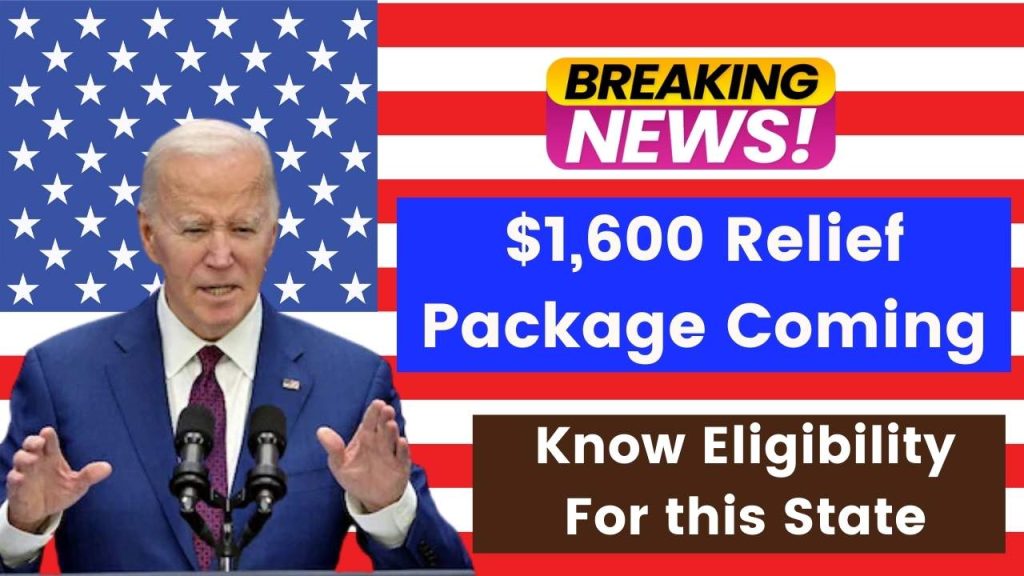$1,600 Relief Package Coming In November: As inflation and cost-of-living pressures weigh on families, some U.S. states are stepping in to help. This November, residents in select states may be eligible for a $1,600 relief package aimed at easing financial burdens and supporting essential needs. This article provides an in-depth look at who qualifies, how to apply, and how to maximize these funds. Whether you’re looking for extra support or simply curious about state assistance programs, here’s everything you need to know.

$1,600 Relief Package Coming In November
| Details | Description |
|---|---|
| Relief Amount | $1,600 |
| Eligibility | Income-based, varies by state |
| Application Period | November 1-30, 2024 |
| Participating States | Varies, with examples like California and New Jersey |
| Intended Use | Housing, utilities, groceries, other essentials |
| Official Resource | Visit the State’s Relief Program Site |
The $1,600 Relief Package offers critical support for residents in select states, providing a one-time cash boost to help with rising living costs. If you believe you’re eligible, applying could be a meaningful step toward financial stability this winter. Visit your state’s official website to confirm eligibility, apply, and secure your support.
Taking advantage of available resources can make a real difference. For more information, be sure to check your state’s relief program page and stay informed about future assistance programs.
$1,600 Relief Package: Why Now?
In recent years, households across the U.S. have faced increasing economic challenges, from pandemic-related disruptions to soaring inflation and rising housing costs. While federal relief initiatives, such as enhanced child tax credits and stimulus checks, provided temporary relief, state-specific assistance packages are now addressing more localized needs.
For many states, the $1,600 relief package is a proactive measure aimed at preventing issues like housing instability, food insecurity, and debt accumulation. The funds are designed to provide quick, one-time assistance to eligible residents, helping to stabilize finances and prepare for future expenses, such as heating bills in winter.
Example: In New Jersey, relief programs target low-income residents and seniors who struggle with the rising costs of essential services, while California offers targeted aid based on median income and family size.
$1,600 Relief Package Eligibility Requirements
Each state has its eligibility criteria, but here’s a general overview of what to expect.
Income Limits
Income requirements often align with the Federal Poverty Level (FPL) or a state-specific income threshold. For example, individuals earning below 200% of the FPL may qualify in some areas.
Residency and Citizenship
Applicants must generally be legal residents of the state offering the package and, in some cases, U.S. citizens or legal permanent residents.
Current Benefit Recipients
Some states may automatically qualify those already receiving state assistance (e.g., SNAP, Medicaid) for the relief package. This minimizes the need for additional documentation and speeds up the approval process.
$1,600 Relief Package Apply Guide
Applying for the $1,600 Relief Package is straightforward, but early preparation can help ensure you submit everything correctly and on time.
- Visit Your State’s Official Website: Begin by visiting your state’s relief program site (e.g., example.gov) to review eligibility criteria, deadlines, and other requirements.
- Gather Required Documents: Have your proof of income, residency, and identification ready to speed up the application process. Common documents include:
- Recent pay stubs, tax returns, or Social Security award letters
- Lease agreements, utility bills, or state ID for residency verification
- A state-issued ID or Social Security card for identity verification
- Complete the Online Application: Most states offer an online application portal where you can submit documents and track your application status. Be thorough—double-check each section to avoid processing delays.
- Submit the Application: Once you’ve filled out the application and uploaded all required documents, submit it online. Some states may also accept in-person applications at local government offices.
- Follow-up: Track your application status online. Approval timelines can vary but generally take between 1-3 weeks.
Helpful Hint: Apply early in the month, as some states have a limited budget for these payments. Once funds run out, applications may close.
$1,600 Relief Package Can Make a Difference
While $1,600 may not cover all expenses, it can still significantly impact recipients by helping them catch up on critical bills or purchase necessities. Here are some of the ways people are using these funds:
- Rent and Housing Costs: For many, the relief package helps cover rent or mortgage payments, especially as rental prices continue to climb.
- Utility Bills: With winter approaching, funds often go toward heating or electricity bills, especially in colder states.
- Food and Essentials: Rising food costs mean that many recipients allocate funds to stock up on groceries or other household essentials.
- Medical Bills or Childcare: Families may also apply funds toward medical expenses or childcare, making it easier to manage day-to-day expenses.
Real-Life Examples
Maria from California used her relief funds to cover unexpected medical expenses, easing her financial stress and allowing her to save for upcoming holidays.
Sam and Eva in New Jersey allocated their funds toward utility costs, reducing the strain of winter heating bills.
$16,800 Expense Payment Aid Only For These Americans In November 2024: Check How to get it
Social Security Payments Halted This Week in November 2024: Check Your Eligibility and Amounts
$8000 SSI Hike For Married SSI Recipients In 2024: Know Eligibility & Application Process
Economic Impact of Relief Packages on Local Communities
Relief packages benefit not only recipients but also the local economy. By distributing funds, states encourage spending within local businesses and service providers, which in turn helps stimulate regional economic growth.
For example, economists note that during the 2020-2021 stimulus checks, many Americans used funds to pay off debts or make necessary purchases, leading to increased retail sales and boosted community spending. Similarly, these relief funds can positively impact local economies, especially in lower-income areas.
Practical Tips for Applicants
If you’re applying for the relief package, here are a few tips to ensure a smooth experience:
- Beware of Scams: Relief packages attract scammers. Only apply through official state websites and avoid sharing personal information with third parties.
- Check Your Information: Double-check your application to ensure accuracy and avoid delays.
- Seek Assistance: If you have questions or difficulty with the application, contact your state’s relief program hotline or local government office.
- Plan Your Spending: Consider how you’ll use the funds before receiving them. Budgeting the money for essentials or upcoming bills can help maximize its impact.
FAQs on $1,600 Relief Package
1. Do I have to pay back the $1,600 relief package?
No, the relief package is a one-time grant, meaning it does not need to be repaid.
2. Can I apply if I already receive government assistance?
Yes, most states allow recipients of other assistance programs, like SNAP or Medicaid, to apply. In some cases, this may even streamline your application.
3. How soon will I receive the funds after my application is approved?
Typically, recipients can expect to receive the funds within 1-3 weeks, depending on processing times.
4. What if I make a mistake on my application?
Contact your state’s program office as soon as possible to correct any errors.
5. Are there restrictions on how I can spend the relief money?
Most states don’t closely monitor spending, but the funds are intended for essential needs, such as housing, food, and utilities.

